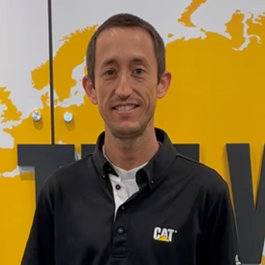At a mine in Australia, a yellow haul truck is traversing the dirt roads of a mine site. As the truck approaches, the truly massive size of the truck comes into perspective: the machine is as large as a 2 ½ story house. But even more impressive is that there is not a person in the cab. This is a fully autonomous haul truck, emblazoned with the name Caterpillar.
For over 95 years, the equipment manufacturer has brought scenes such as this one to life, fueling the world’s construction and mining industries.
But just because miners have access to big machines doesn’t mean their work is simple.
It’s often described as “dull, dirty and physically daunting,” according to Dr. Patrick Rowe, an autonomy senior staff engineer at Caterpillar. That’s why he and his peers on the company’s autonomy and automation team developed a solution that takes human labor out of the cab – but not out of the equation.
The company develops and supports the world’s largest fleet of autonomous haul trucks, which navigate mine sites without the need for an operator on board. Currently, over 590 of these machines — each one approximately the size of a two-story home — traverse 25 mine sites across the globe. In 10 years of autonomous hauling, these machines have racked up over 216 million miles without a single injury.
So what makes it possible for these hulking machines to move on their own? Rowe said one critical tool is the company’s perception system, a feature of Cat® MineStar™ Command for hauling. This technology enables the trucks to navigate landscapes, understand and respond to their surroundings.
For mining operators, the benefits of these trucks are manifold. Anthony McNealy, a chief engineer with the Autonomy and Automation (A&A) group, said the machines provide a safer, more predictable outcome. Instead of having a fleet of operators at a highly remote location, site controllers located miles away can oversee their operations.
Those involved in the company’s autonomy and automation endeavors not only have the chance to impact industries — they can build upon an exciting sector. The autonomous technology industry has faced fierce economic headwinds over the past few months, yet, according to team members at Caterpillar, the company continues to invest in future autonomous capabilities.
Rochelle Mans joined the team for this very reason. “It puts Caterpillar in a different category than many of the tech companies working on autonomy,” Mans said.
“[Continuous investment in future capabilities] puts Caterpillar is in a different category than many of the tech companies working on autonomy.”
SUPPORTING CRITICAL INDUSTRIES
Caterpillar provides products and services to the mining, construction, energy, railroad and maritime transportation sectors.
Building Intelligent, Autonomous Machines
Autonomy and automation aren’t anything new for the team at Caterpillar. The company has invested in this area of its business for over three decades and has produced several classes of autonomous machines, including large mining trucks, water trucks, tractors and blasthole drills. Underground, automated load haul dump machines improve equipment utilization.
The success of the company’s automated machines is rooted in GPS. Many of us rely on this tool every day, whether we’re using it to find the nearest coffee shop on our phone or locate our friend’s house while driving. Yet, when it comes to autonomous machinery, it isn’t powerful enough to stand on its own.
According to Rowe, GPS doesn’t work underground, nor does it function very well amongst tall buildings. That’s where radars, LiDAR (light detection and ranging) and cameras come in, providing the perception and adding to the safety layers needed for the machines to effectively operate.
Rowe said that LiDAR — like that commonly found in self-driving vehicles — uses laser energy to measure the time of flight of a pulse of light as it reflects off an object. By knowing the speed of light, you can calculate the distance of that object.
Rowe added that present-day sensors can take millions of measurements a second — but that’s just the beginning.
“My focus is on interpreting these millions of measurements a second, which are just XYZ coordinates,” he said. “If I ever gave you a list of XYZ coordinates on paper, you probably couldn't tell me what shape it made. Similarly, that’s the challenge we have in determining what’s at a mine site.”
Using these coordinates, Rowe and his team determine how to ensure the trucks safely navigate landscape shifts, such as downward slopes or steep hills, as well as other vehicles.
Mans said this complex calculation significantly reduces the possibility of human error and adds layers of safety and perception beyond the capabilities of a human operator — a crucial element given the potential safety challenges involved in mining.
Cameras are another critical sensor used on these autonomous systems. Advances in image processing and using deep learning technologies provides the ability to detect and define people, animals, vehicles and landscaping around the machine.
McNealy said Caterpillar’s haul trucks could be seen as highly intelligent robots with the ability to traverse terrain unique to the individual mine sites. This offers technologists the chance to tackle intricate challenges with the potential to redefine how the company supports its customers.
“There’s a lot of opportunity to really impact our customers’ ability to solve their business problems and affect their bottom line,” McNealy said.
“There’s a lot of opportunity to really impact our customers’ ability to solve their business problems and affect their bottom line.”
Curiosity is Key
If you think this type of work requires an extensive background in robotics, you’re wrong.
According to McNealy, new team members don’t have to have traditional robotics experience. He has seen people with strong software engineering skills or experience as a data scientist become integral members of the team. Beyond these skillsets is an essential key to success — an unwavering sense of curiosity.
“If they’re curious, they can get up to speed quickly and become a productive member of the team,” he said.
McNealy would certainly know what it means to be curious at Caterpillar. For the past 19 years, he’s worked across several different teams at the company, including a stint in Japan where he developed hydraulic excavator electric systems. Over the years, he has discovered that the most essential team members on any team are those who continually search for more.
The desire to seek new solutions is essential, considering the company stays up to date with the latest changes across the industry. Mans said team members must be adaptable, embrace an out-of-the-box mindset and bring a fresh perspective.
“In mature companies, I often see people fall into a rhythm, which is why it’s beneficial for us to bring in a different perspective and challenge existing processes,” she said.
While ambition, flexibility and intelligence are important characteristics to have on the company’s tech teams, all of these attributes mean nothing without the right attitude. Rowe considers it essential for team members to have strong communication and collaboration skills.
“It’s important to play well with others and respect other people’s opinions,” he said.
Opportunity Lies Ahead
The team at Caterpillar carefully considers the people they hire, for a reason. McNealy said, “Our technology is because of our people. As we carefully consider the people we hire, we’re looking for people that can help refine our current capabilities as well as drive the development of exciting new products for the future.”
Mans is equally energized by the prospect of adding more team members. With a diverse range of backgrounds, she and her peers will have more opportunities to make an impact.
“Having the opportunity to work with people who have different experiences and new perspectives is one thing I'm super excited about for our team,” she said.
So what else does the future hold for Caterpillar? Among other things, it involves a newly announced collaboration with Luck Stone, which, according to McNealy, will enable Caterpillar to move beyond large, remote mine sites and into smaller quarry operations. “We’re excited to see what we can do,” he said.
For Rowe, his time at the company has been “the missing piece” of his career. For the first time in his professional career, he can see the systems he developed move from testing to application in the real world.
“I want to point to something and say, ‘I helped build that,’” he said. “This is my best chance to actually achieve that.”








